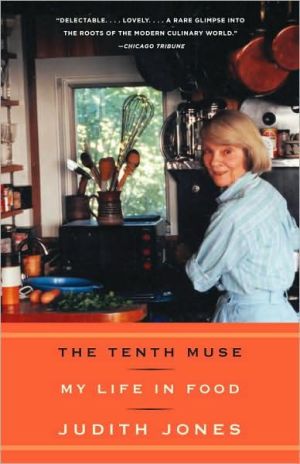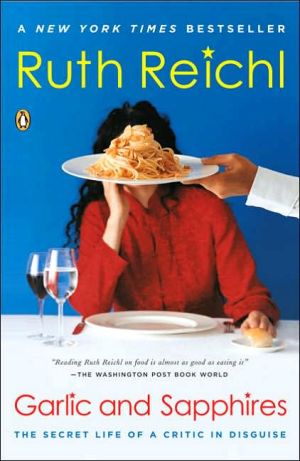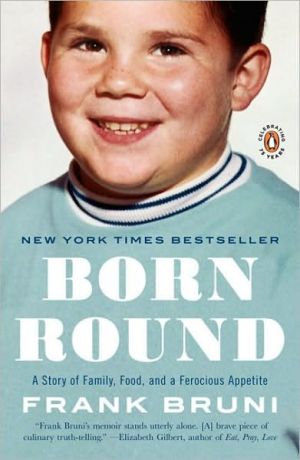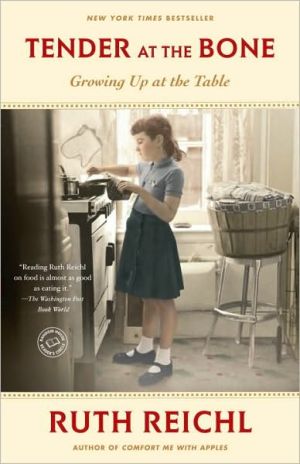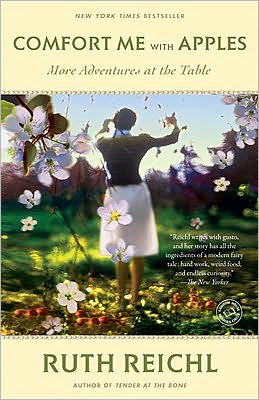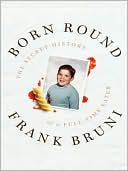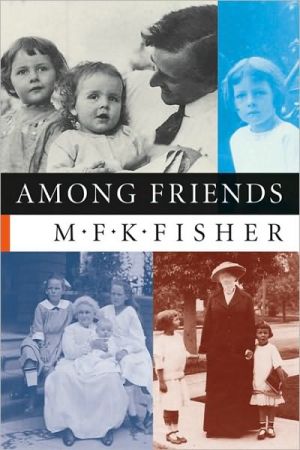The Tenth Muse: My Life in Food
From the legendary editor who helped shape modern cookbook publishing-one of the food world's most admired figures-comes this evocative and inspiring memoir. \ Living in Paris after World War II, Jones broke free of bland American food and reveled in everyday French culinary delights. On returning to the States she published Julia Child's Mastering the Art of French Cooking. The rest is publishing and gastronomic history. A new world now opened up to Jones as she discovered, with her husband...
Search in google:
From the legendary editor who helped shape modern cookbook publishing-one of the food world's most admired figures-comes this evocative and inspiring memoir. Living in Paris after World War II, Jones broke free of bland American food and reveled in everyday French culinary delights. On returning to the States she published Julia Child's Mastering the Art of French Cooking. The rest is publishing and gastronomic history. A new world now opened up to Jones as she discovered, with her husband Evan, the delights of American food, publishing some of the premier culinary luminaries of the twentieth century: from Julia Child, James Beard, and M.F.K. Fisher to Claudia Roden, Edna Lewis, and Lidia Bastianich. Here also are fifty of Jones's favorite recipes collected over a lifetime of cooking-each with its own story and special tips. The Tenth Muse is an absolutely charming memoir by a woman who was present at the creation of the American food revolution and played a pivotal role in shaping it. Publishers Weekly The title of this testament to one woman's appetite comes from Brillat-Savarin, who wrote of a 10th muse-Gasterea, goddess of the pleasures of taste. Many food writers would argue that this 10th muse is actually Judith Jones. For nearly half a century, Jones, an editor of literary fiction and a senior vice-president at Knopf, has served as midwife to some of the most culturally significant cookbooks of our time, introducing readers to newly discovered talents like Julia Child, Marcella Hazan, Madhur Jaffrey and Claudia Roden, to name but a few. In this quiet, spare memoir, set against the shifting landscape of modern cookery in America, Jones reveals herself to be every bit as evangelical about good food and honest cooking as her authors, locating the points where her relationships with these writer-gastronomes and her own gustatory education converged. She ran an illegal restaurant in Paris, learned from Julia Child to de-tendon a goose (a set of maneuvers involving a broomstick), received a tutorial in fresh-bagged squirrel from Edna Lewis and counted James Beard among her mentors. At the end, the book is tinged with sadness over the decline of serious home cooking and the current fixation on dishing up fast and easy mediocrities. But Jones's belief in the primordial importance of cooking well is ultimately inspiring, and it fires these pages as it has fired her life. (Oct.)Copyright 2007 Reed Business Information
Bread Pudding\ SERVES: 4 to 6\ At a country inn in Wales, I had one of those taste-memory moments that made me realize how a simple pudding of eggs, bread, and milk could in a flash call up a flood of memory so acute that for an instant I was right back in childhood. The baked dish was brought in, wrapped in a white linen napkin, the way Edie would have served it, and as it was spooned onto the plate I had my first whiff. Then, when I took a taste, the hot raisins bursting in my mouth, the sensation was so powerful that the tears rolled down my cheeks (adding a little salty flavor).\ NOTE: I discovered from Edna Lewis how much better crushed sugar cubes are than plain granulated sugar as a topping. They're particularly good if you've stored them in a jar with a vanilla bean. Bread pudding is best warm, but it can be very good cold, too. I've even had it for breakfast straight from the fridge.\ Ingredients\ 2 1/2 cups milk\ 2 tablespoons butter, plus a little for buttering the dish\ 3 slices homemade-type bread, crusts removed, crumbled to make 1 ½ cups\ 1/2 cup raisins Grated rind of ½ lemon\ 1/2 teaspoon lemon juice\ 3 large eggs\ 3 tablespoons sugar About 4 gratings of nutmeg (about 1/8 teaspoon)\ For topping:\ Crushed sugar cubes, to make about 2 tablespoons\ For serving:\ Heavy cream\ 1. Heat the milk with the butter, stirring until melted.\ 2. Remove from the heat, stir in the crumbled bread, the raisins, grated lemon rind, and lemon juice, and let cool to lukewarm.\ 3. Separate the eggs, and beat the yolks into the milk and butter along with the sugar.\ 4. Beat the whites in a clean bowl until they form soft peaks, and fold them into the pudding mixture.\ 5. Season the mixture with nutmeg, and turn into a lightly buttered shallow baking dish. Sprinkle the crushed sugar cubes on top.\ 6. Set the dish in a pan of simmering water, and bake in a preheated 325-degree oven for 1 hour. Serve warm with a pitcher of heavy cream.\ \ \ Chapter One: Growing Up\ \ When my mother was well into her nineties, she announced that she had an important question for me and wanted an honest answer. I steeled myself for something weighty, perhaps about whether I believed in heaven and hell.\ \ Then she looked at me and asked: “Tell me, Judith, do you really like garlic?” I couldn’t lie. Yes, I admitted, I adored garlic. She looked so crestfallen at that moment that I was sure she felt a sense of finality about the wayward path her younger daughter had taken.\ \ To her, garlic represented everything alien and vulgar. It smelled bad, and people who handled it or ate it smelled bad. Moreover, it covered up the natural flavor of honest food—and that was suspect. Those French chefs, for instance, why did they have to put a sauce on everything, anyway? No doubt to disguise the taste because what was underneath wasn’t very fresh to begin with.\ \ In my mother’s house we were always being told to get rid of the smells, to make sure that the kitchen door was shut, that the windows were open. Not only was garlic banned, onions were permitted only when a lamb stew was being prepared, for which two or three well-boiled small white onions per person were deemed appropriate. That’s all that were purchased; Mother didn’t want our cook, Edie Price, sneaking a little chopped onion into her meatloaf. And heaven forbid that indigestible, raw pieces might find their way into a tuna-fish sandwich.\ \ Still, I have to admit that the unadulterated English-style food I grew up on had its merits. I always loved our Sunday dinner prime rib roast with Yorkshire pudding, which my British grandfather, whenever he was present, would carve at the table, deftly cutting thin—too thin, I always thought—rosy slices. My father, Charles Bailey, who was called Monty because he grew up in Montpelier, Vermont, somehow never lost the mischievous charm of a small-town boy after he had to settle in New York City. When he married into the Hedley family, he made a point of carving clumsy, thick slices, and so was banished as the family carver. My mother took over. I can still see her standing at the head of the table honing her knife on a sharpening steel, and I would always try to sneak a nibble from the platter when she wasn’t looking. The knuckle-bone meat on a lamb roast was irresistible.\ \ I am grateful, too, that those organ meats that people spurn today often graced our table: liver and bacon, beefsteak and kidney pie, breaded sweetbreads—I lapped them up and still find all forms of innards an earthy delight. Frugality was considered a virtue. One never let things go to waste, so our cook, Edie, learned to turn leftovers into wonderful dishes: crispy croquettes with creamy lamb, ham, or chicken inside; shepherd’s pie of ground-up leftover lamb with a mashed-potato topping; minced meats in cream on toast; stuffed vegetables. We also had a meatless night once a week, either for the sake of economy or because it was good for us to forgo the pleasure of flesh, I’m not sure. For quite a few years after I graduated from the nursery table to the grown-up dinner table, I thought when we were served breaded and fried eggplant or broiled mushrooms that they were a form of meat. Of course, I didn’t dare ask, because one wasn’t supposed to talk about food at the table (it was considered crude, like talking about sex). And if we indulged in appreciative sounds like “yum-yum,” we just might be sent from the table.\ \ Nor could we make disparaging remarks if something displeased us. I remember how endlessly long the winter seemed when all that Mr. Volpe, our Italian fruit-and-vegetable vendor on the corner, could produce was overgrown root vegetables, sprouts and cabbage, and tired potatoes. Then what greens we could get were cooked so long that an unappetizing cabbagy smell permeated the air, and it was hard to get down our due portion. But we weren’t allowed to say a word. It did take me some time, though, to appreciate parsnips and broccoli. When, finally, spring broke through and we tasted our first asparagus, even though slightly overcooked, it was a treat worth waiting for. And we were allowed to pick up the spears with our fingers.\ \ But I don’t remember ever going shopping with my mother in the city to pick out the first vegetables and fruits of the season. Food shopping was invariably done by phone, as though to keep a distance from the things of the earth. In the summer, though, a truck with fresh farm produce would do a tour of the lake in Vermont where we had our summer cottage, and it was fun to go out and greet the local farmer and get a look at what he had just pulled from the soil. Every week the butcher’s truck would stop by, and I once persuaded him to let me ride with him as he made his rounds. I was impressed with the way he wielded his knife and would lop off a slab of meat which, when he put it on the scales, would always come within an ounce of what the customer had ordered. The back of the truck was chilled only by a block of ice, and as the warmth of the summer day penetrated, the smell of raw meat became tantalizingly strong.\ \ Meat was such an important part of everyone’s diet that when we were plunged into World War II and were suddenly confronted with rationing, there was a sense of deprivation. I was away at college in Bennington, Vermont, in those years, and we had a huge Victory Garden in which all had to participate. I remember how the erudite critic Kenneth Burke insisted that he conduct his class out in the burgeoning fields, because he felt that having our feet planted firmly in the soil and nurturing the fruits of the earth would encourage our minds to soar. We were also asked to volunteer for poultry duty, and I felt very virtuous beheading and plucking and eviscerating chickens by the dozens—all in expectation of a good dinner, of course. Bennington was known for its superior food, and I’m not ashamed to admit that, after sampling the fare at a number of sister colleges, I just may have chosen Bennington because I liked to eat well.\ \ Meanwhile, back home in New York, meat was scarce. My parents had acquired a Kerry blue terrier, no doubt to fill the gap left by their last daughter’s going off to college, and they were finding it so hard to get enough meat to feed this hungry animal that they finally gave him to Albert, the butcher. Or so the story goes. The other version is that my mischievous father, now that there were no children around, had to take the dog out every night for what seemed increasingly long walks. Now, in those days, Third Avenue in the East Sixties was still a thoroughly Irish neighborhood; the el rattled through, and there was a pub on every corner. During the daytime, when my mother walked the dog, she began to notice how he would stop at several of the nearby pubs and pull her in, tail wagging in happy anticipation of a doggy treat. Then it dawned on her why those evening walks were taking Monty so long. She quickly made an arrangement with the butcher.\ \ But back to those earlier childhood memories at the table. Above all, we always ate what was put in front of us, especially if we wanted dessert. To me those homemade desserts of British ancestry were the crowning glory of the meal, and I wouldn’t have missed them for anything. I still feel nostalgic for the warm chocolate steamed pudding with foamy sauce, the bread pudding with its crusty top and raisins bursting inside, the apple brown Betty made with good tart country apples, the floating island with its peaks of egg white swimming in a sea of yellow custard. Then, when summer came, there were the summer puddings, a bread-lined mold steeped in just-cooked blueberries, raspberries, or blackberries as each came in season, pressed, chilled, and unmolded, with thick unpasteurized cream poured over each serving. Edie had some specialties of her own, such as individual warm nut-and-date cakes, and meringues (which we called kisses) topped with bananas and slathered in hand-beaten whipped cream.\ \ I loved watching Edie with a big mustard-colored ceramic bowl cradled on her hip as she would beat a batter with her strong brown arm, her wooden spoon hitting the bowl with a plopping sound. In fact, the kitchen was where I headed as soon as I got off the school bus and threw down my books. Not only did I want to know what was for dinner and to watch it all magically come together, but I was fascinated by Edie’s other life. She came from Barbados and at my urging would tell me about the foods she grew up on—strange fruits I’d never heard of, hot peppers that made one sweat, and, of course, garlic. I’d sometimes get cheeky enough to ask what she was going to make for her boyfriend on her Thursday night off, and as she described the food, I would long to have her spirit me off to Harlem with her. Instead, to spare my mother having to cook, we were taken to a prissy little restaurant on Lexington Avenue called Susan Prince that served the kind of food we had at home.\ \ When I was asked during my middle-school years what I would like for lunch on Fridays—the day when we had to stay in school until only one o’clock—I knew exactly what I wanted: a whole artichoke, spaghetti and cheese, and fresh fruit or applesauce for dessert. The spaghetti and cheese that Edie made was more sauce than pasta (a term we didn’t even know then—it was either spaghetti or macaroni), enriched with massive gratings of good Vermont Cheddar cheese, then baked in a casserole with buttered crumbs and more cheese on top. I made a ritual of slurping down those hot creamy strands of spaghetti and alternately picking off artichoke leaves, one by one, dipping them in lemony butter or hollandaise, and scraping off the flesh with my teeth. I did it slowly, often turning the pages of a book. Then, when I got to the heart, I would carefully pull off all the thistles and revel in that concentrated, slightly grassy-tasting artichoke flesh. If I had a sip of milk, it was curious how the artichoke flavor distorted the taste of the milk. I found the same true when I graduated to wine. So this was one taste treat better just enjoyed on its own.\ \ My father soon recognized that I inherited the food genes from his side of the family and decided to treat me to more adventurous fare. So on Saturdays he would take me to lunch at La Petite Maison, a typical French restaurant near us in Manhattan’s East Sixties, and there I was able to wallow in onions as I broke through the cheesy toasted crust of a soupe à l’oignon or to savor seafoods wrapped in delicate warm crêpes, to say nothing of mopping up those winey sauces that hid who knows what. The only trouble was that quite often by mid-afternoon I would start throwing up. I could just hear my mother saying: See what happens to a child when she eats those foreign foods. But I was not to be deterred: We gradually isolated the culprit and found that I was allergic to scallops.\ \ Incidentally, for many years I had to forgo those wonderful sea-briny mollusks, but when I was in my forties, my husband, Evan, who didn’t really believe in allergies, started experimenting to see if he could wean me. Unbeknownst to me, he would slip just a shaving of a scallop into my serving of a fish soup he had made, and when there was no adverse reaction he would sneak a larger portion into whatever seafood dish he made next time. After several years of increasing doses, I was able to consume happily a whole plateful of fresh scallops, and I have been making up for my years of deprivation ever since. The moral of this story is not only that you shouldn’t cling to childhood prejudices—try to get over them—but also remember that the body changes, and what poisoned you at ten years old may well nourish you pleasurably in middle life.\ \ I think my most important awakening to the pleasures of cooking came when I was about eleven and bargained with my parents to let me spend one winter with my grandmother in Montpelier. After I’d convinced them, my mother blurted out anxiously: “But what if you get sick?” My answer was that I had no intention of getting sick. And, of course, I didn’t. Instead, I grew up.\ \ I particularly loved spending time with my Aunt Marian, who lived a little way down the street from my grandmother’s house. After school and on weekends, I would stop by and settle into her warm, sweet-smelling kitchen and watch as she prepared dishes she knew her husband liked. Uncle Doc was a popular GP in town, and often his visits to patients would last into the evening. But no matter the hour, Aunt Marian always had a hot dish and all the accompaniments ready and waiting for his return. I marveled not only at how she could be so flexible and have everything turn out just right, but also at the love she seemed to express in cooking. She kept notebooks of her favorite recipes, some clipped from the Ladies’ Home Journal and Good Housekeeping, and she would tuck in alongside them a poem she liked, or some pressed flower or herbs that might have decorated that particular dish. The household had a hired girl who did some of the chores, but to Aunt Marian the idea of anyone aside from his own devoted wife cooking for Uncle Doc, or even ironing his shirts, was unthinkable. One thing she made that I always loved was timbales created out of scraps of ham she had in the icebox mixed with eggs, milk, and breadcrumbs. It seemed so magical that you could put these simple ingredients together, bake them in buttered custard cups, and, when they were done, turn them upside down and see the perfectly formed timbale plop neatly onto the plate. As we took these trembling timbales out onto the porch to eat for lunch in summer, Aunt Marian would pluck off an edible flower or two to decorate the plates.\ From the Hardcover edition.
\ Publishers WeeklyThe title of this testament to one woman's appetite comes from Brillat-Savarin, who wrote of a 10th muse-Gasterea, goddess of the pleasures of taste. Many food writers would argue that this 10th muse is actually Judith Jones. For nearly half a century, Jones, an editor of literary fiction and a senior vice-president at Knopf, has served as midwife to some of the most culturally significant cookbooks of our time, introducing readers to newly discovered talents like Julia Child, Marcella Hazan, Madhur Jaffrey and Claudia Roden, to name but a few. In this quiet, spare memoir, set against the shifting landscape of modern cookery in America, Jones reveals herself to be every bit as evangelical about good food and honest cooking as her authors, locating the points where her relationships with these writer-gastronomes and her own gustatory education converged. She ran an illegal restaurant in Paris, learned from Julia Child to de-tendon a goose (a set of maneuvers involving a broomstick), received a tutorial in fresh-bagged squirrel from Edna Lewis and counted James Beard among her mentors. At the end, the book is tinged with sadness over the decline of serious home cooking and the current fixation on dishing up fast and easy mediocrities. But Jones's belief in the primordial importance of cooking well is ultimately inspiring, and it fires these pages as it has fired her life. (Oct.)\ Copyright 2007 Reed Business Information\ \ \ \ \ Library JournalJones (coauthor, The L.L. Bean Game and Fish Cookbook; The Book of New New England Cookery) is a longtime editor and friend to many culinary celebrities, including Julia Child, James Beard, and Chuck Williams (of Williams-Sonoma fame). Jones traces the interesting history of American trends in food during recent times-from prepared food to ethnic foods to vegetarian fare and beyond. Her stories of Child reinforce our notion that she was indeed a colorful and talented cook; we also find out how Beard came to be known as a bread-making wizard. There are useful, straightforward recipes for hermit bars, "Frenchified" meatloaf, bread pudding, frozen maple mousse, flummery, and some harder-to-find dishes. In addition to mouthwatering descriptions of various dishes, Jones offers an inside scoop on the publishing world. The story of her life is enjoyable in itself, and the added tales of the famous are the frosting. For most public libraries and academic libraries with a special interest in cookery.\ —Elizabeth Rogers\ \ \ \ Kirkus ReviewsA senior editor at Knopf reflects on her long love affair with food and cooking, with friends and family-and with writing about them all. Jones has had a distinguished editing career. Early on, she urged Doubleday, her employer at the time, to publish The Diary of a Young Girl by unknown Anne Frank; at Knopf, she introduced the world to cooking mavens Julia Child, Claudia Roden and Marion Cunningham among others. Jones begins her memoir at home (her mother hated garlic), then moves gracefully forward, recounting an early trip to Paris that revealed to her the glories of cooking and eating. She soon met and married her husband of nearly 50 years, Evan Jones, who grew to share her passions. Many of the most tender moments in this most tender of narratives involve their elegant choreography in the kitchen. The author would eventually meet and befriend the world's most celebrated cooks and bakers (James Beard appears here regularly), and she soared to a spectacular career. Of course, there were problems and failures and losses: She recommended a series of cookbooks that bombed; she struggled with the sometimes cantankerous writers (including a contretemps with Marcella Hazan concerning yeast); she lost her husband in 1996 and faced for the first time in a half century a lonely kitchen-but not for long, as her vivacious grand-niece soon appeared. Jones offers some insider's detail-Beard kneaded bread with one hand; beaver tail is tough to penetrate-and appends a wonderfully eclectic list of recipes (brains with a mustard coating, anyone?), but it's regrettable that she does not always prepare her sentences as well as her sweetbreads. Cliches ("fell on deaf ears," "tough nut to crack,""crowning moment") appear with alarming regularity throughout and affect her prose in the way a single bad egg affects an otherwise fabulous omelet. Affectionate, passionate and informative, but lacks the deep reflection of the finest memoir. First printing of 50,000\ \
